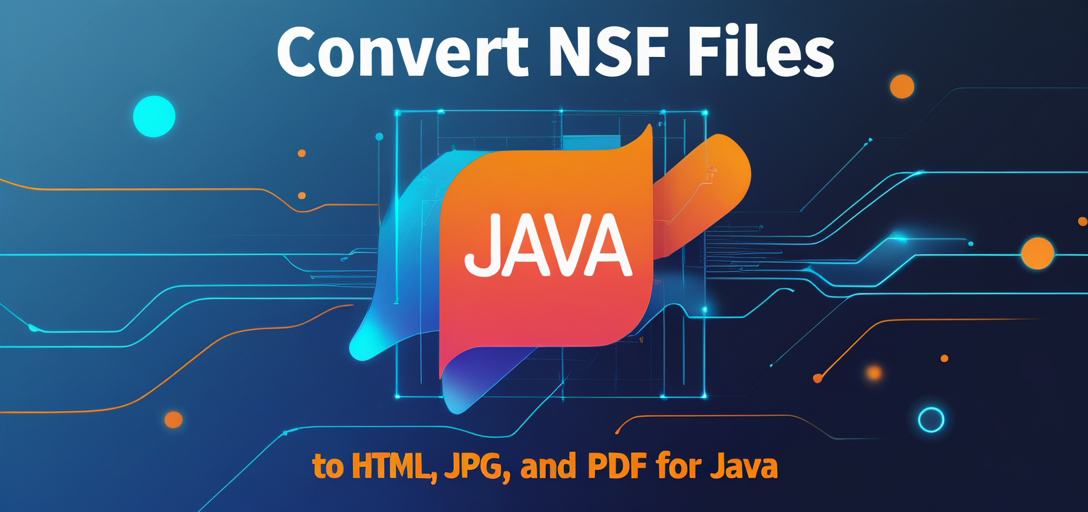Convert NSF Files to Multiple Formats Using GroupDocs.Viewer for Java
Introduction
Converting NSF documents into different formats such as HTML, JPG, PNG, or PDF using Java is straightforward with GroupDocs.Viewer for Java. This guide will walk you through the process, from setup to implementation, providing insights into the benefits and best practices.

Key topics include:
- Setting up GroupDocs.Viewer for Java
- Rendering NSF documents into various formats
- Optimizing performance with load options and view settings
- Integrating conversion features within applications
Prerequisites
Before implementing GroupDocs.Viewer for Java, ensure you have the following:
- Libraries and Dependencies:
- Maven (for dependency management)
- JDK 8 or later installed on your system.
- Environment Setup:
- Basic understanding of Java programming
- Familiarity with Maven for project setup
- Knowledge Prerequisites:
- File handling in Java basics
- Document conversion concepts
Setting Up GroupDocs.Viewer for Java
Maven Configuration
Incorporate GroupDocs.Viewer into your Java project by adding the following configuration to your pom.xml:
<repositories>
<repository>
<id>repository.groupdocs.com</id>
<name>GroupDocs Repository</name>
<url>https://releases.groupdocs.com/viewer/java/</url>
</repository>
</repositories>
<dependencies>
<dependency>
<groupId>com.groupdocs</groupId>
<artifactId>groupdocs-viewer</artifactId>
<version>25.2</version>
</dependency>
</dependencies>
License Acquisition
To use GroupDocs.Viewer, you can:
- Free Trial: Access basic functionalities to evaluate the tool.
- Temporary License: Obtain a temporary license for full features.
- Purchase: Consider purchasing a license for production environments.
Basic Initialization
Initialize GroupDocs.Viewer as follows:
import com.groupdocs.viewer.Viewer;
public class InitializeViewer {
public static void main(String[] args) {
try (Viewer viewer = new Viewer("YOUR_DOCUMENT_DIRECTORY/SAMPLE_NSF")) {
// Viewer is ready for use.
}
}
}
Implementation Guide
Rendering NSF to HTML
Overview
Convert NSF documents into HTML format, embedding resources within the HTML for easy web viewing.
Step-by-Step Guide:
1. Set Up Output Directory and File Path Define where your output HTML files will be stored.
import java.nio.file.Path;
import java.nio.file.Paths;
Path outputDirectory = Paths.get("YOUR_OUTPUT_DIRECTORY");
Path pageFilePathFormat = outputDirectory.resolve("NSF_result.html");
2. Configure Load Options Customize the loading process with specific options such as resource loading timeouts.
import com.groupdocs.viewer.options.LoadOptions;
LoadOptions loadOptions = new LoadOptions();
loadOptions.setResourceLoadingTimeout(100); // Set timeout for loading resources.
3. Initialize Viewer and Render Use the Viewer class to render your document into HTML format.
import com.groupdocs.viewer.Viewer;
import com.groupdocs.viewer.options.HtmlViewOptions;
try (Viewer viewer = new Viewer("YOUR_DOCUMENT_DIRECTORY/SAMPLE_NSF", loadOptions)) {
HtmlViewOptions options = HtmlViewOptions.forEmbeddedResources(pageFilePathFormat);
viewer.view(options); // Render the document to HTML.
}
Rendering NSF to JPG
Overview
Convert NSF documents into high-quality JPG images for sharing or integration into image-based systems.
1. Define Output Path Set up the file path format for storing rendered JPGs.
Path pageFilePathFormat = outputDirectory.resolve("NSF_result_{0}.jpg");
2. Configure and Render Set up your viewer and render the document as JPEG images.
import com.groupdocs.viewer.options.JpgViewOptions;
try (Viewer viewer = new Viewer("YOUR_DOCUMENT_DIRECTORY/SAMPLE_NSF", loadOptions)) {
JpgViewOptions options = new JpgViewOptions(pageFilePathFormat);
viewer.view(options); // Render to JPG.
}
Rendering NSF to PNG
Overview
Render documents into PNG format, known for its lossless compression and high resolution.
1. Set Output Path
Path pageFilePathFormat = outputDirectory.resolve("NSF_result_{0}.png");
2. Render Document
import com.groupdocs.viewer.options.PngViewOptions;
try (Viewer viewer = new Viewer("YOUR_DOCUMENT_DIRECTORY/SAMPLE_NSF", loadOptions)) {
PngViewOptions options = new PngViewOptions(pageFilePathFormat);
viewer.view(options); // Convert to PNG.
}
Rendering NSF to PDF
Overview
Convert NSF documents into PDF format, a universally accepted document standard.
1. Define Output Path
Path pageFilePathFormat = outputDirectory.resolve("NSF_result.pdf");
2. Render as PDF
import com.groupdocs.viewer.options.PdfViewOptions;
try (Viewer viewer = new Viewer("YOUR_DOCUMENT_DIRECTORY/SAMPLE_NSF", loadOptions)) {
PdfViewOptions options = new PdfViewOptions(pageFilePathFormat);
viewer.view(options); // Convert to PDF.
}
Practical Applications
- Web-Based Document Sharing: Render NSF files into HTML for easy sharing on web platforms.
- Image Archiving: Store high-quality images of documents in JPG or PNG formats.
- Universal Document Access: Use PDF conversion for universal document compatibility across devices.
Performance Considerations
- Optimize Resource Loading: Adjust
setResourceLoadingTimeoutbased on your system’s capabilities. - Memory Management: Ensure efficient memory use by properly managing Viewer instances with try-with-resources.
- Batch Processing: For large-scale conversions, consider processing documents in batches to manage resource utilization.
Conclusion
This guide has explored how to render NSF documents into various formats using GroupDocs.Viewer for Java. By following these steps, you can seamlessly integrate document conversion capabilities into your applications. Explore further features of GroupDocs.Viewer and consider integrating them into your projects.
FAQ Section
- What is the best format for converting NSF documents?
- It depends on your needs: HTML for web viewing, PDF for universal access, JPG/PNG for images.
- How do I handle large NSF files efficiently?
- Consider optimizing load options and processing in batches.
- Can I customize output quality in image formats?
- Yes, adjust parameters like resolution when setting up JpgViewOptions or PngViewOptions.
- What should I do if the conversion fails?
- Check file paths, ensure proper setup of Viewer instances, and refer to GroupDocs documentation for troubleshooting tips.
- Is there a way to automate these conversions in batch processes?
- Absolutely! Implementing a loop over multiple documents can automate this process efficiently.